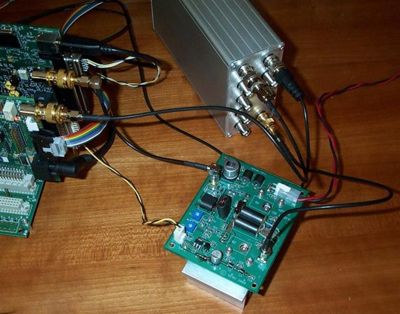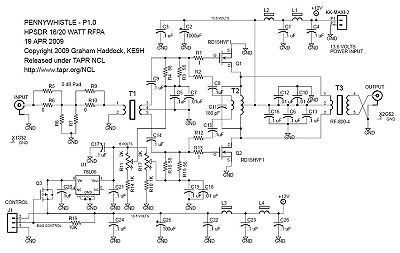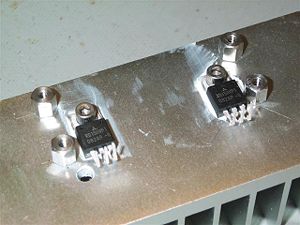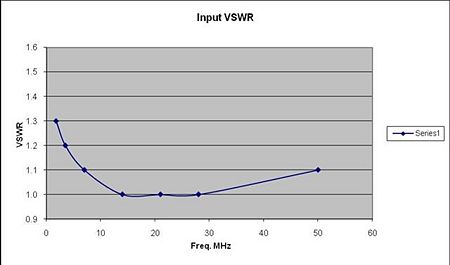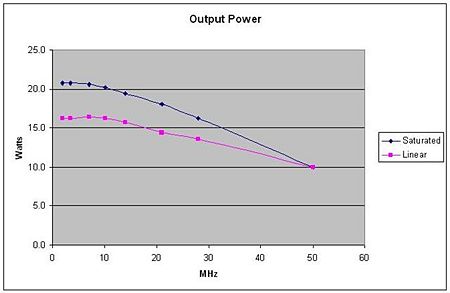Difference between revisions of "PENNYWHISTLE"
(→added comment about feedback winding) |
|||
| (9 intermediate revisions by 2 users not shown) | |||
| Line 1: | Line 1: | ||
| − | [[Image:DCP_3376_(Small).JPG|thumb|400px|PennyWhistle 16 to 20 Watt RF PA using Mitsubishi | + | [[Image:DCP_3376_(Small).JPG|thumb|400px|PennyWhistle 16 to 20 Watt RF PA using Mitsubishi RF Power Transistors]] |
| − | PennyWhistle is a compact RF power amplifier that can be used with [[PENELOPE|Penelope]] and [[ALEXIARES|Alex]] to make a complete 16 Watt PEP Linear or 20 Watt saturated CW transmitter. This amplifier can quickly and inexpensively be used to get an HPSDR on the air, either barefoot, or as a driver for a larger linear. It covers the same 160 Meter through 6 Meter bands as the rest of HPSDR. | + | '''PennyWhistle''' is a compact RF power amplifier that can be used with [[PENELOPE|Penelope]] and [[ALEXIARES|Alex]] to make a complete 16 Watt PEP Linear or 20 Watt saturated CW transmitter. This amplifier can quickly and inexpensively be used to get an HPSDR on the air, either barefoot, or as a driver for a larger linear. It covers the same 160 Meter through 6 Meter bands as the rest of HPSDR. |
| − | + | ||
| − | + | ||
It is 10 cm by 8 cm (half Euro-board size.) | It is 10 cm by 8 cm (half Euro-board size.) | ||
| Line 8: | Line 6: | ||
== DESCRIPTION == | == DESCRIPTION == | ||
| − | The amplifier has a single push-pull output stage that uses a pair of TO-220 “15 Watt” Mitsubishi RD15HVF1 parts, and has approximately 19 dB gain, depending where you bias it, so it will deliver 16 to 20 watts output with one-fourth watt drive. | + | The amplifier has a single push-pull output stage that uses a pair of TO-220 “15 Watt” Mitsubishi RD15HVF1 or RD16HHF1 parts, and has approximately 19 dB gain, depending where you bias it, so it will deliver 16 to 20 watts output with one-fourth watt drive. |
I would expect this could be sold as a bare PC build-it-yourself kit. It uses surface mount, but would be easy to build. There are two easily wound transformers and the output transformer is preassembled and wound, from Communications Concepts. As a pure kit, hopefully it could be offered in the same time frame as ALEX, and let people get on the air. | I would expect this could be sold as a bare PC build-it-yourself kit. It uses surface mount, but would be easy to build. There are two easily wound transformers and the output transformer is preassembled and wound, from Communications Concepts. As a pure kit, hopefully it could be offered in the same time frame as ALEX, and let people get on the air. | ||
| Line 18: | Line 16: | ||
PennyWhistle requires a low pass filter between the output of PennyWhistle and the antenna in order to meet regulatory requirements for harmonic emissions. When used in conjunction with ALEX, the low pass filter bank in ALEX will provide this low pass filtering requirement. | PennyWhistle requires a low pass filter between the output of PennyWhistle and the antenna in order to meet regulatory requirements for harmonic emissions. When used in conjunction with ALEX, the low pass filter bank in ALEX will provide this low pass filtering requirement. | ||
| − | [[Image:PW_P1.0_Sch_Med.JPG| | + | [[Image:PW_P1.0_Sch_Med.JPG|thumb|400px|Schematic]] |
| − | [[Image:HS_Mounting.JPG| | + | [[Image:HS_Mounting.JPG|thumb|300px|The two output transistors are actually mounted underneath the PC board, with their heat sink tabs bolted to the main heatsink.]] |
The PCB is mounted to the main heatsink with ¼ inch long #4-40 spacers at four locations in the vicinity of the PA transistors. The leads from the transistors are bent upwards and through the PCB and soldered from the top. Holes in the PCB allow unbolting the transistors from the main heatsink if needed, without having to unsolder anything. | The PCB is mounted to the main heatsink with ¼ inch long #4-40 spacers at four locations in the vicinity of the PA transistors. The leads from the transistors are bent upwards and through the PCB and soldered from the top. Holes in the PCB allow unbolting the transistors from the main heatsink if needed, without having to unsolder anything. | ||
| Line 26: | Line 24: | ||
In the normal 16/20 Watt application, the feedback winding on T2, R2, R12, C8 and C15 would not be populated. They are only used if you want to reduce power output, by using negative feedback, to some lower level. So they are there only as an | In the normal 16/20 Watt application, the feedback winding on T2, R2, R12, C8 and C15 would not be populated. They are only used if you want to reduce power output, by using negative feedback, to some lower level. So they are there only as an | ||
option for special applications. | option for special applications. | ||
| + | |||
== TEST RESULTS == | == TEST RESULTS == | ||
| − | [[Image:PW_Input_VSWR_(Small).JPG| | + | |
| + | [[Image:PW_Input_VSWR_(Small).JPG|thumb|450px|PennyWhistle input VSWR (without input attenuator]] | ||
Two tone testing, at rated 16 Watt PEP levels for linear operation on 20 Meters provides third order IM levels of 30 dB below test tone, or 36 dB below PEP. Fifth order IM levels are 50 dB below test tone, or 56 dB below PEP. These IM levels are about the same at lower frequencies and slowly degrade as you go up in frequency. | Two tone testing, at rated 16 Watt PEP levels for linear operation on 20 Meters provides third order IM levels of 30 dB below test tone, or 36 dB below PEP. Fifth order IM levels are 50 dB below test tone, or 56 dB below PEP. These IM levels are about the same at lower frequencies and slowly degrade as you go up in frequency. | ||
| − | [[Image:Output_(Small).JPG| | + | [[Image:Output_(Small).JPG|thumb|450px|PennyWhistle Output versus frequency]] |
The convergence of the linear and saturated lines at 6 Meters is an artifact of being drive limited by Penelope. With a higher drive level, the actual linear and saturated output levels at 6 Meters are about the same as 10 Meters. | The convergence of the linear and saturated lines at 6 Meters is an artifact of being drive limited by Penelope. With a higher drive level, the actual linear and saturated output levels at 6 Meters are about the same as 10 Meters. | ||
== CURRENT STATUS == | == CURRENT STATUS == | ||
| + | |||
| + | October 31, 2009 | ||
| + | |||
| + | The kits are shipping, and Version 1.1 of the manual has been posted. | ||
| + | |||
| + | October 17, 2009 | ||
| + | |||
| + | The project is in kitting, and the manual has been posted to the Support >> HPSDR Manuals page on the Wiki | ||
| + | * http://openhpsdr.org/documents.php | ||
April 19, 2009 | April 19, 2009 | ||
| Line 43: | Line 52: | ||
== RELATED DOCUMENTS AND LINKS == | == RELATED DOCUMENTS AND LINKS == | ||
| + | Manual: | ||
| + | * [[Media:PennyWhistle_Manual_V1.1.pdf |PennyWhistle_Manual_V1.1.pdf]] | ||
| − | The | + | The full manual has also been posted to the Support >> HPSDR Manuals page on the Wiki |
| − | + | * http://openhpsdr.org/documents.php | |
| − | + | ||
| − | + | ||
| − | http://www.rfparts.com/pdf_docs/RD/rd15hvf1.pdf | + | The RF power transistors used in this design are true RF power transistors, although quite inexpensive and packaged in plastic TO-220 packages. As true RF transistors, the metal heat sink tabs on the transistors are at ground potential, so can be directly attached to the metal heat sink. |
| + | * http://www.rfparts.com/pdf_docs/RD/rd15hvf1.pdf | ||
| + | * http://www.rfparts.com/pdf_docs/RD/rd16hhf1.pdf | ||
The PCB cards and schematics are designed in EAGLE Layout Editor | The PCB cards and schematics are designed in EAGLE Layout Editor | ||
| + | * http://www.cadsoftusa.com/ | ||
| + | * http://www.cadsoft.de/ | ||
| − | + | [[Category:Hardware available]] | |
| − | + | ||
| − | + | ||
Latest revision as of 23:23, 26 November 2011
PennyWhistle is a compact RF power amplifier that can be used with Penelope and Alex to make a complete 16 Watt PEP Linear or 20 Watt saturated CW transmitter. This amplifier can quickly and inexpensively be used to get an HPSDR on the air, either barefoot, or as a driver for a larger linear. It covers the same 160 Meter through 6 Meter bands as the rest of HPSDR.
It is 10 cm by 8 cm (half Euro-board size.)
DESCRIPTION
The amplifier has a single push-pull output stage that uses a pair of TO-220 “15 Watt” Mitsubishi RD15HVF1 or RD16HHF1 parts, and has approximately 19 dB gain, depending where you bias it, so it will deliver 16 to 20 watts output with one-fourth watt drive.
I would expect this could be sold as a bare PC build-it-yourself kit. It uses surface mount, but would be easy to build. There are two easily wound transformers and the output transformer is preassembled and wound, from Communications Concepts. As a pure kit, hopefully it could be offered in the same time frame as ALEX, and let people get on the air.
It will fit in a Euro-Card housing, with an appropriate heat sink., or it can be mounted with a heat sink inside of the Pandora housing. We need to extract about 20 to 25 watts of heat when transmitting continuously. Dissipation in standby is negligible. The circuit is capable of continuous duty, provided that the heatsink is big enough to hold a reasonable temperature.
PennyWhistle requires a low pass filter between the output of PennyWhistle and the antenna in order to meet regulatory requirements for harmonic emissions. When used in conjunction with ALEX, the low pass filter bank in ALEX will provide this low pass filtering requirement.
The PCB is mounted to the main heatsink with ¼ inch long #4-40 spacers at four locations in the vicinity of the PA transistors. The leads from the transistors are bent upwards and through the PCB and soldered from the top. Holes in the PCB allow unbolting the transistors from the main heatsink if needed, without having to unsolder anything.
In the normal 16/20 Watt application, the feedback winding on T2, R2, R12, C8 and C15 would not be populated. They are only used if you want to reduce power output, by using negative feedback, to some lower level. So they are there only as an option for special applications.
TEST RESULTS
Two tone testing, at rated 16 Watt PEP levels for linear operation on 20 Meters provides third order IM levels of 30 dB below test tone, or 36 dB below PEP. Fifth order IM levels are 50 dB below test tone, or 56 dB below PEP. These IM levels are about the same at lower frequencies and slowly degrade as you go up in frequency.
The convergence of the linear and saturated lines at 6 Meters is an artifact of being drive limited by Penelope. With a higher drive level, the actual linear and saturated output levels at 6 Meters are about the same as 10 Meters.
CURRENT STATUS
October 31, 2009
The kits are shipping, and Version 1.1 of the manual has been posted.
October 17, 2009
The project is in kitting, and the manual has been posted to the Support >> HPSDR Manuals page on the Wiki
April 19, 2009
Assembly and testing of the Alpha cards is complete, and the design has been released to TAPR for kitting and distribution.
RELATED DOCUMENTS AND LINKS
Manual:
The full manual has also been posted to the Support >> HPSDR Manuals page on the Wiki
The RF power transistors used in this design are true RF power transistors, although quite inexpensive and packaged in plastic TO-220 packages. As true RF transistors, the metal heat sink tabs on the transistors are at ground potential, so can be directly attached to the metal heat sink.
The PCB cards and schematics are designed in EAGLE Layout Editor

